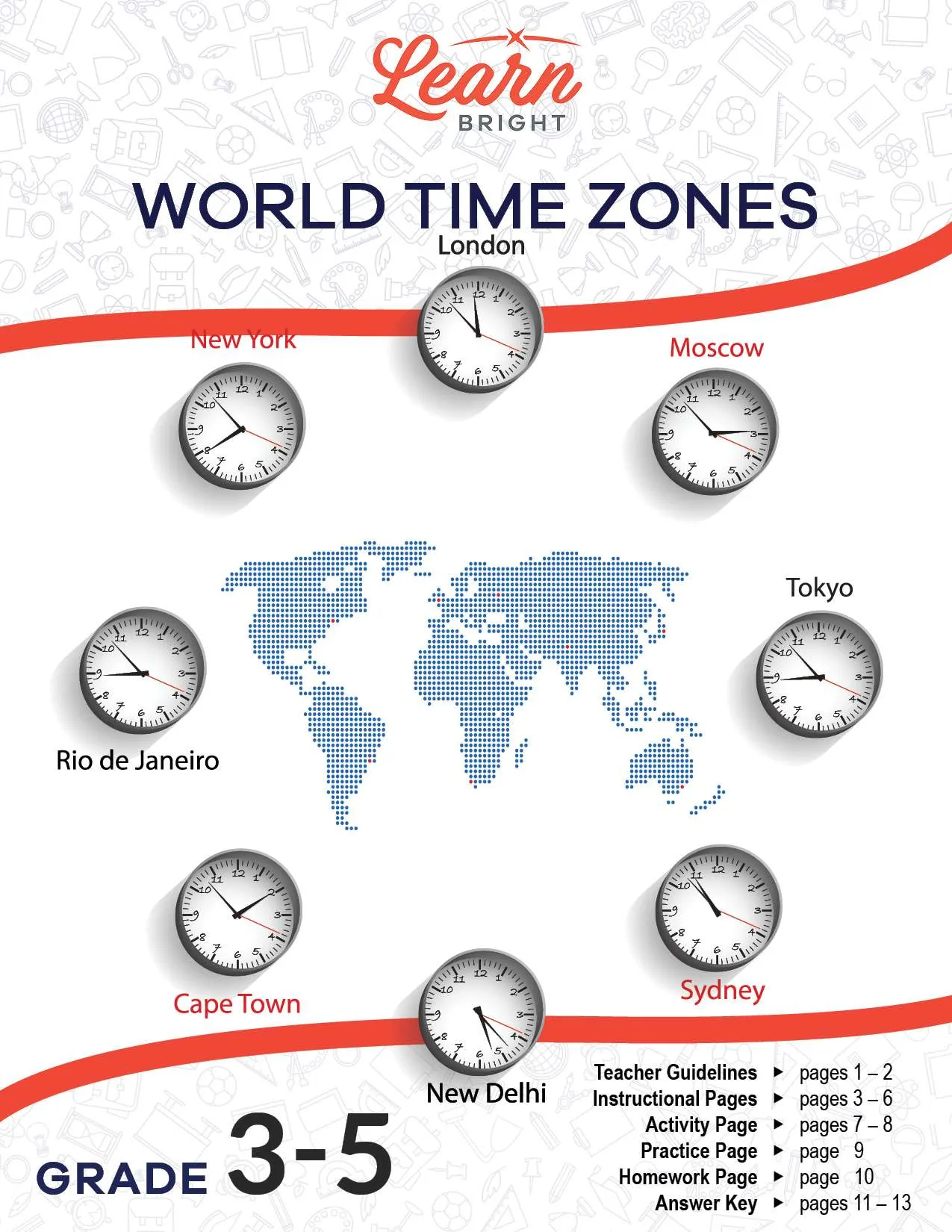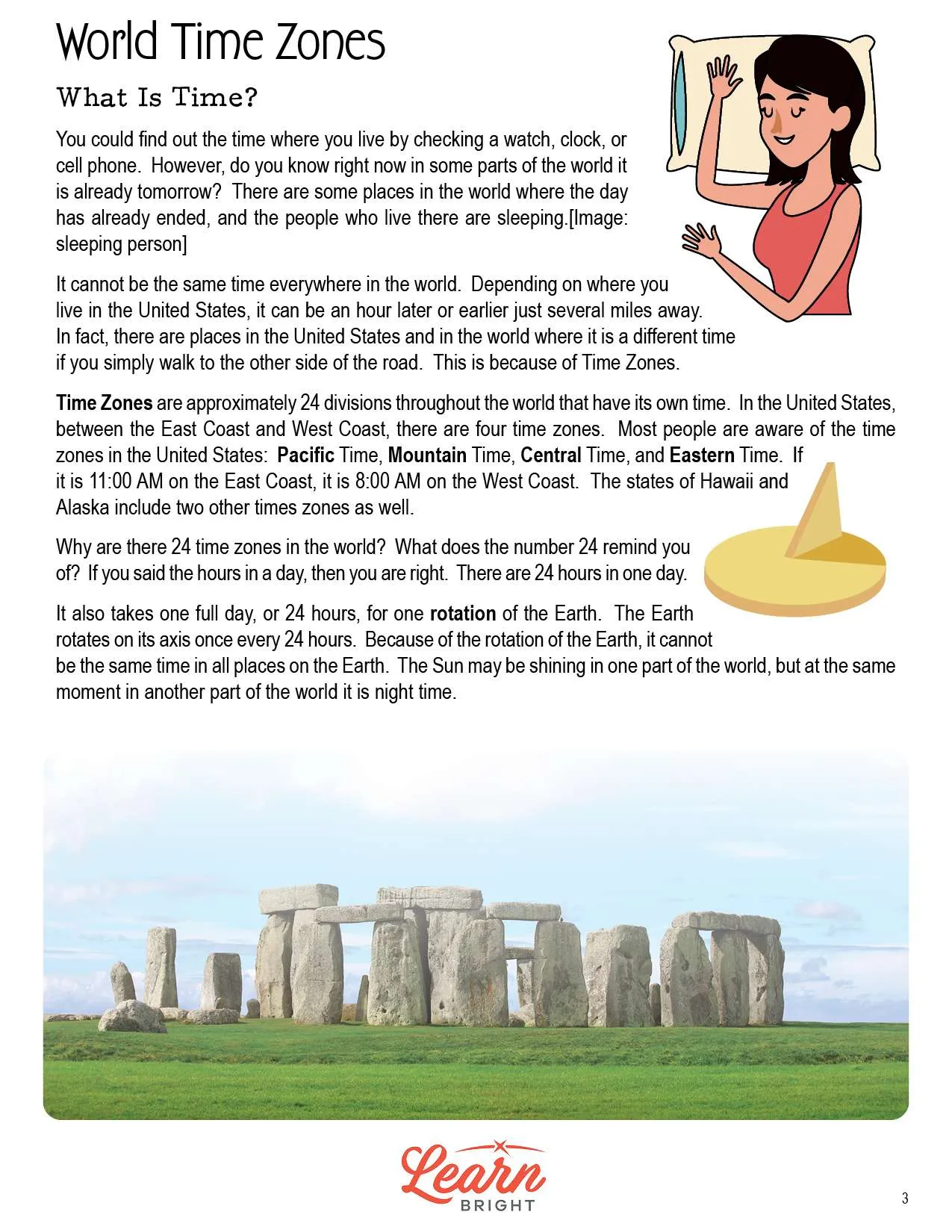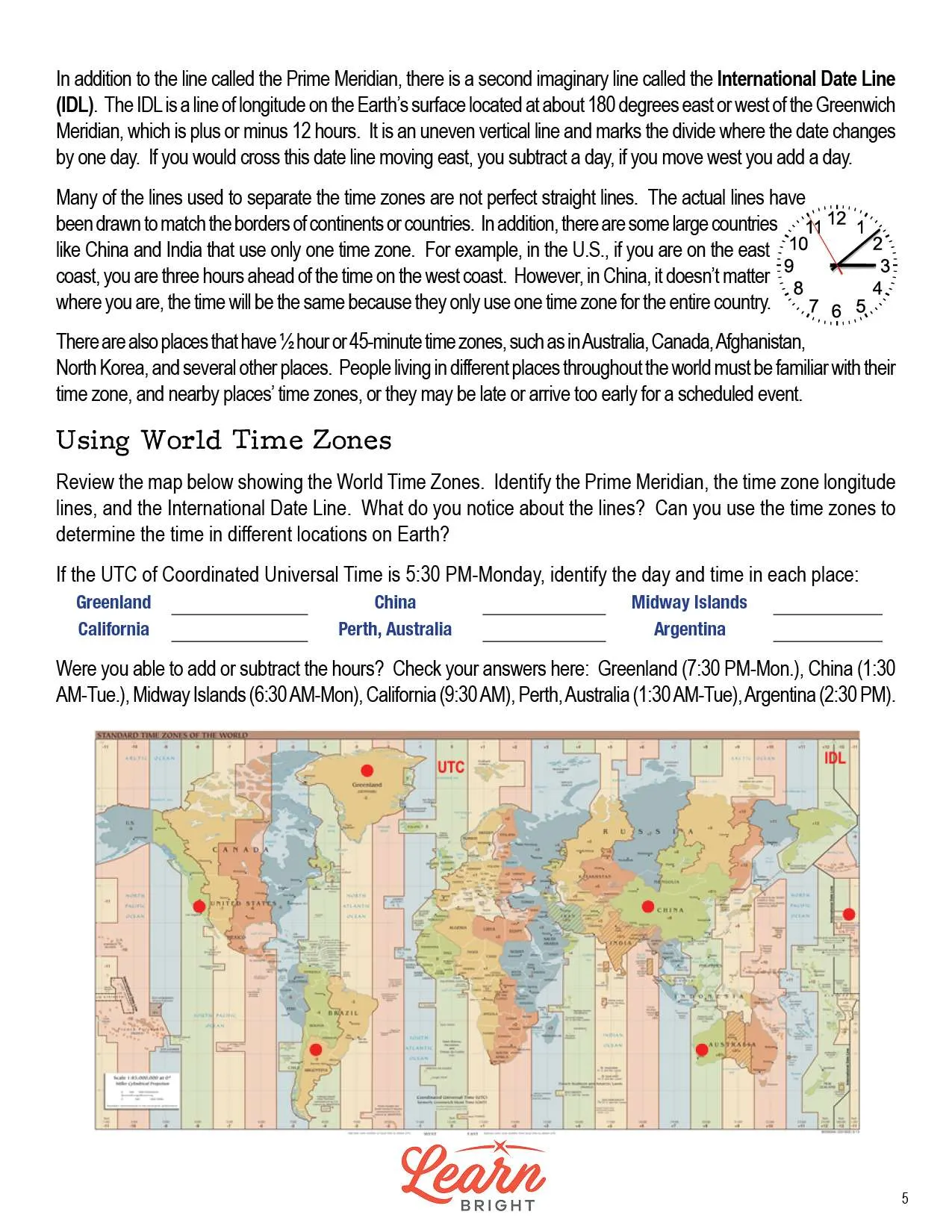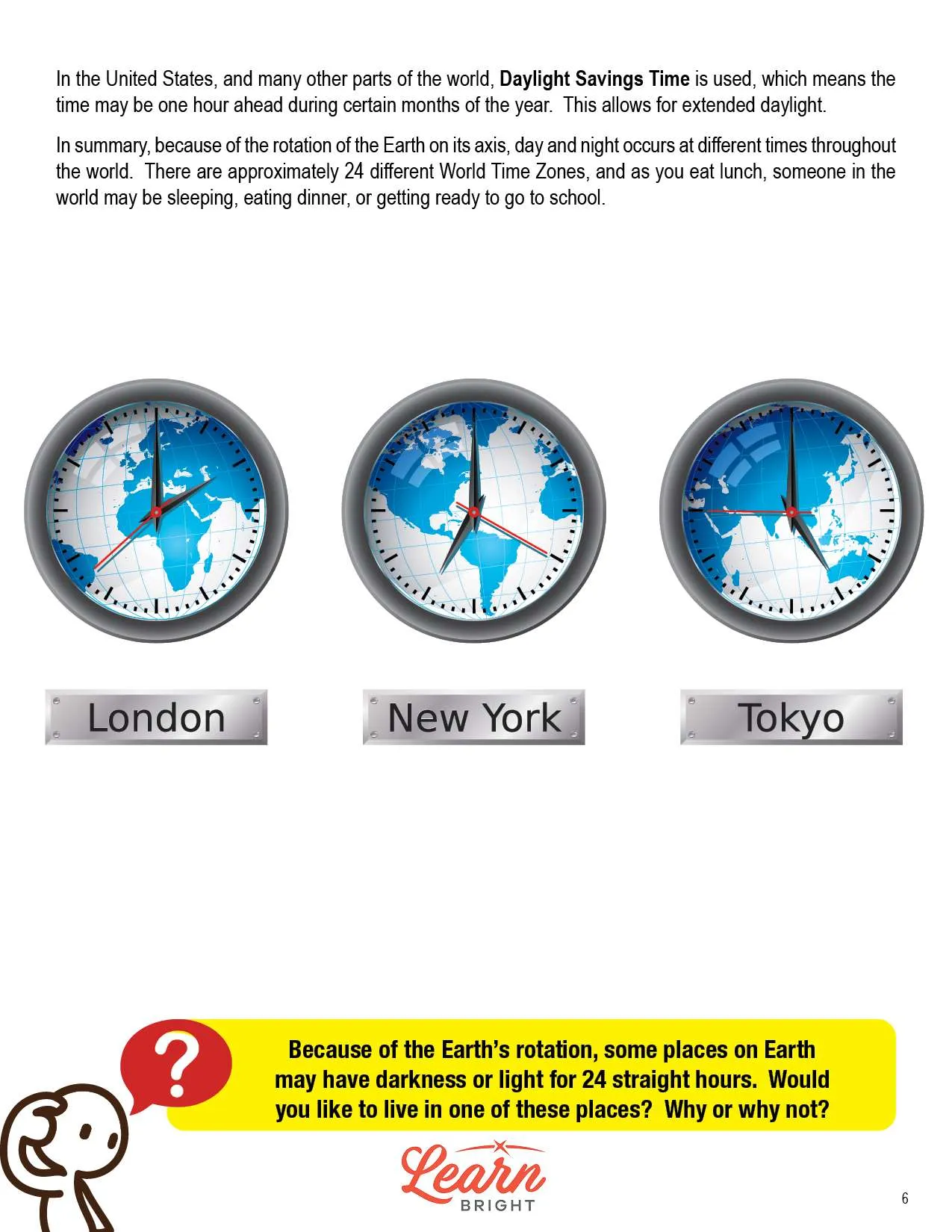Description
What our World Time Zones lesson plan includes
Lesson Objectives and Overview: World Time Zones introduces students to world time zones and the reasons for the different time zones. Most students understand time zones exist, but may not understand fully the reasons for the time zones. At the end of the lesson, students will be able to define and describe world time zones and identify and explain the reasons for time zones across the world. This lesson is for students in 3rd grade, 4th grade, and 5th grade.
Classroom Procedure
Every lesson plan provides you with a classroom procedure page that outlines a step-by-step guide to follow. You do not have to follow the guide exactly. The guide helps you organize the lesson and details when to hand out worksheets. It also lists information in the yellow box that you might find useful. You will find the lesson objectives, state standards, and number of class sessions the lesson should take to complete in this area. In addition, it describes the supplies you will need as well as what and how you need to prepare beforehand. The supplies you will need for this lesson are flashlights, balls or globes, and the handouts.
Options for Lesson
Included with this lesson is an “Options for Lesson” section that lists a number of suggestions for activities to add to the lesson or substitutions for the ones already in the lesson. One optional addition to the lesson is to go outside and create chalk outlines of the world with time zones, having students travel between them while identifying the time. You can also have your students research why we have Daylight Savings Time. They can also research areas where people frequently cross time zone boundaries. You can also invite a person who’s traveled across the world to speak to your class about time zones. Finally, you can use the lesson activity for students to identify capital cities across the world.
Teacher Notes
The teacher notes page includes a paragraph with additional guidelines and things to think about as you begin to plan your lesson. This page also includes lines that you can use to add your own notes as you’re preparing for this lesson.
WORLD TIME ZONES LESSON PLAN CONTENT PAGES
What Is Time?
The World Time Zones lesson plan includes four pages of content. The lesson begins by reminding students that they can find out what time it is using watches or clocks. However, there are places in the world where it’s a different time. It could even be tomorrow already!
It is not the same time everywhere in the world. If you live near another time zone, it might be an hour earlier or later just a few miles away. This happens because we use time zones. Time zones are roughly 24 different divisions throughout the world that each have their own time. There are four time zones in the United States alone: Pacific time, Mountain time, Central time, and Eastern time. If it’s 11:00 am on the East Coast, it is 8:00 am on the West Coast. Hawaii and Alaska are in their own time zones as well.
There are 24 time zones in the world because there are 24 hours in a day. It takes 24 hours for the Earth to travel one rotation on its axis. It can’t be the same time everywhere on Earth because of its rotation. When the sun is out in one part of the world, it’s nighttime somewhere else.
Ancient astronomers built rock circles, towers, and other structures to help tell time, long before clocks or cell phones. We think that they may have used Stonehenge in England as a structure that helped people identify the seasons based on how the sun lined up with the rocks.
Sundials can also tell time during the day. They use the position of the sun in the sky to tell time by using the shadow of the sun as it aligns with different marks on the dial. Unfortunately, sundials don’t work when it’s cloudy or when it’s night. These days, people don’t need to rely on the sun to tell time.
We still determine time based on the Earth’s rotation, but digital clocks and other technology can now calculate the time to billionths of a second. We base the World Time Zones on the rotation of the Earth.
Degrees in a Circle
Degrees in a circle are related to time zones because the Earth is round. The sun can’t shine on the whole Earth at once because of its shape, but the sun always shines somewhere on Earth. A circle has 360 degrees and the Earth rotates in a circle. Because we knew all of this, we were able to create time zones in the late 1800s.
A circle has 360 degrees. When you break it into 24 sections, each section has 15 degrees. If the Earth spins on its axis in a circle, each 15 degrees of movement is another hour of time. A full rotation is one day.
They based the World Time Zones on these 24 equal sections. The Earth is a sphere, not a flat circle, so they divided it into longitude lines. The distance between time zones is larger at the equator and smaller at the poles.
The Beginning of Time Zones
These imaginary time zone lines start at Greenwich, near London, England. We call this line the prime meridian (or Greenwich Meridian) and this time zone Greenwich Mean Time. If you move west, each time zone makes it one hour earlier. If you move east, each time zone makes it one hour later. West is earlier and east is later.
We base the time everywhere on Greenwich Mean Time, also called the UTC or Coordinated Universal Time. UTC is the standard time, and we keep it using very precise atomic clocks. Everywhere else uses this clock to set their time, by adding or subtracting hours depending on which time zone they are in. If you look at a time zone map and see numbers like +5 or -3, that number tells you how many hours to add or subtract from UTC to determine the time in that place.
We also use another imaginary line called the International Date Line (IDL). The IDL is a longitude line located about 180 degrees west of UTC. This line marks the divide where the date changes by one day. If you cross this date line moving east, you subtract a day. If you cross it moving west, you add a day.
Many of the lines that we use to delineate time zones are not straight lines. We’ve drawn some of the actual lines to match borders of continents or countries. Some countries don’t even use time zones, like China and India. Even though China is very large, they use the same time zone throughout the entire country.
Some places also have smaller time zones that are different by half an hour or 45 minutes, like Australia, Canada, Afghanistan, and North Korea. It’s important to be aware of your time zone!
Using World Time Zones
The lesson includes a map that shows the World Time Zones and asks students to identify the Prime Meridian, time zone longitude lines, and the International Date Line. It asks what they notice about the lines. It also asks them to try to convert time zones to different locations.
In the United States, we also use Daylight Savings Time. This means that the time is an hour ahead during certain months of the year, which allows people to enjoy extended daylight.
To summarize, day and night occur at different times throughout the world because Earth rotates on its axis. We have about 24 different World Time Zones, which means that while you eat lunch, people around the world are going to sleep, eating dinner, or waking up.
WORLD TIME ZONES LESSON PLAN WORKSHEETS
The World Time Zones lesson plan includes three worksheets: an activity worksheet, a practice worksheet, and a homework assignment. You can refer to the guide on the classroom procedure page to determine when to hand out each worksheet.
TIME ZONE CONVERSION ACTIVITY WORKSHEET
Students will work with a partner to complete the activity worksheet. Each pair will use the World Map to identify different time zones. They will fill in the provided chart with times and cities. For each time and city pair, they will choose two more cities that are in different time zones. They will convert the time from the first time and city pair to the time it would be in each of the other cities that they chose. They will also create a copy of their chart, leaving the time zones conversions blank. Next, they will swap their charts with another pair of students. They will fill in each other’s charts.
Students can also work either alone or in groups to complete this activity.
WORLD TIME ZONES PRACTICE WORKSHEET
The practice worksheet asks students to first answer questions using terms from the provided word bank. Next, they will do a few time zone conversions. Finally, they will answer a few questions about the lesson material.
WRITING QUESTIONS HOMEWORK ASSIGNMENT
For the homework assignment, students will first write questions for the given answers related to time zones. Next, they will read ten statements and will determine whether each is true or false.
Worksheet Answer Keys
This lesson plan includes answer keys for the practice worksheet and the homework assignment. If you choose to administer the lesson pages to your students via PDF, you will need to save a new file that omits these pages. Otherwise, you can simply print out the applicable pages and keep these as reference for yourself when grading assignments.









